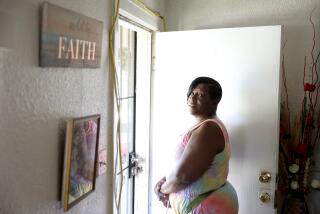Campaign Underway to Recruit Foster Parents
- Share via
The 7-month-old Santa Paula girl had two broken legs and a family in chaos. But when she was ready to leave the hospital this month, social workers had to scramble to find a foster family that would accept her.
This kind of situation occurs all too frequently in Ventura County, social workers say. The shortage of foster care has prompted county officials to launch a three-year campaign to encourage residents to open their homes to abused or endangered children in need of temporary shelter.
The county has 160 foster homes, down from 363 in 1991. About 40 children enter foster care each month, and about half as many leave the system to be reunited with their parents, live with relatives or be adopted.
County Department of Children and Family Services statistics show that Oxnard needs 52 more foster homes; Ventura, 29; Santa Paula and Fillmore combined, 14; Port Hueneme, 14; Thousand Oaks, Newbury Park and Westlake combined, 10; and Moorpark, 10.
“People aren’t aware of the need and sometimes they’re scared away by what they believe these children are like,” said Ventura County Juvenile Court Judge Charles Campbell, a key supporter of the recruitment effort. “They’re just kids like everyone else. We’re trying to get the word out to people that they should be responsible for the children in their community.”
Because there aren’t enough foster homes in many county cities to meet the demand, children are often placed in homes far from their parents and schools. This makes education, visitation and family reunification all the more difficult.
If a foster home cannot be found, the children are sent to Casa Pacifica emergency shelter in Camarillo or one of two temporary homes contracting with the county that will keep a child for up to 30 days.
But the county wants to place children into a nearby foster home as quickly as possible, one that can keep them as long as needed.
“The idea is to have choices and options so we can best match children to homes,” said Trish Cavanaugh, foster care administrator for Children and Family Services. “What happens now is [that] a child may come in and we have one bed available for that age and sex, and it may not be the best place for them.”
The local foster care shortage parallels a sharp decline nationally, caused largely by economics, Cavanaugh said. With many more two-earner families, parents have fewer hours to spend with their own children, much less someone else’s, she said.
Nevertheless, county social workers and their supporters believe they can make a dent in the problem by appealing to people who never before thought about being foster parents or who considered it but hesitated.
Officials hope to have a roster of 350 licensed foster families by 2005 after county workers and volunteers visit churches, professional organizations, parent-teacher associations and civic groups to seek recruits.
The shortage is most acute among Latinos, who comprise 52% of children in foster care but only 8% of foster families, Cavanaugh said.
The county places many Latino children in homes that may not reflect their cultural needs, Cavanaugh said. If the children speak only Spanish and their foster families don’t, a difficult situation is worsened, she said.
To combat that, the department recently hired a bilingual recruiter and a bilingual foster-care ombudsman to encourage and help Latino families “take care of their own,” Cavanaugh said. The county also plans to place Spanish-language radio ads, and use other marketing and public relations tools.
Veteran foster parents will serve as mentors to new foster families, helping them adjust to their roles.
“Just knowing that you’ve helped out a child when they really needed it is a wonderful thing,” said Simi Valley resident Mariana Abarta, a foster parent for 16 years.
She and her husband, Steve, parents of three adult children and a teenager, are caring for their 38th and 39th foster child.
Because Abarta is a registered pediatric nurse, the couple chose to foster medically fragile infants who had been abused or were born to drug-addicted mothers.
“Drug babies almost always have long-term effects, because you just don’t know what to expect from the drugs--when the mother took the drugs, how often or how much,” Abarta said. “I’m a good, safe place for them.”
To become a licensed foster parent, applicants must attend an orientation, complete 12 hours of training and have their homes inspected by a social worker.
Families receive $425 to $600 a month per child to cover necessities, such as food and clothing, and $50 to $250 more for special needs, such as transportation to medical appointments.
More to Read
Sign up for Essential California
The most important California stories and recommendations in your inbox every morning.
You may occasionally receive promotional content from the Los Angeles Times.












